Experimental and Numerical Study on the Perforation Behavior of an Aluminum 6061-T6 Cylindrical Shell
Abstract
:1. Introduction
2. Material Models
2.1. Cockcroft–Lathan Fracture Model
2.2. Modified Johnson–Cook Material Model
2.3. Validation of Material Models
3. Ballistic Impact Experiments
4. Results
5. Conclusions
Author Contributions
Funding
Institutional Review Board Statement
Informed Consent Statement
Data Availability Statement
Conflicts of Interest
References
- Kim, K.T.; Lee, C.W. Dynamic analysis of asymmetric bladed-rotors supported by anisotropic stator. J. Sound Vib. 2012, 24, 5224–5246. [Google Scholar] [CrossRef]
- Xue, R.; Jiang, J.; Jackson, A. Effect of bypass ratio on optimal fan outer pressure ratio and performance for turbofan engines. Int. J. Aeronaut. Space Sci. 2019, 20, 157–164. [Google Scholar] [CrossRef]
- Le, D. Evaluation of Light Weight Material Concepts for Aircraft Turbine Engine Rotor Failure Protection; Federal Aviation Administration: Washington, DC, USA, 1997.
- He, Z.; Xuan, H.; Bai, C.; Hu, Y.; Cong, P.; Bai, H.; Hong, W. Containment tests and analysis of soft wall casing fabricated by wrapping Kevlar fabric around thin metal ring. Aerosp. Sci. Technol. 2017, 61, 35–44. [Google Scholar] [CrossRef]
- He, Q.; Xuan, H.; Liu, L.; Hong, W.; Wu, R. Perforation of aero-engine fan casing by a single rotating blade. Aerosp. Sci. Technol. 2013, 25, 234–241. [Google Scholar] [CrossRef]
- He, Q.; Xuan, H.J.; Liao, L.F.; Hong, W.R.; Wu, R.R. Simulation methodology development for rotating blade containment analysis. J. Zhejiang Univ. Sci. A 2012, 13, 239–259. [Google Scholar] [CrossRef]
- Naik, D.; Sankaran, S.; Mobasher, B.; Rajan, S.D.; Pereira, J.M. Development of reliable modeling methodologies for fan blade out containment analysis–Part I: Experimental studies. Int. J. Impact Eng. 2009, 36, 1–11. [Google Scholar] [CrossRef]
- Carney, K.S.; Pereira, J.M.; Revilock, D.M.; Matheny, P. Jet engine fan blade containment using an alternate geometry. Int. J. Impact Eng. 2009, 36, 720–728. [Google Scholar] [CrossRef]
- Heady, J.; Pereira, J.M.; Ruggeri, C.R.; Bobula, G.A. Establishing a Ballistic Test Methodology for Documenting the Containment Capability of Small Gas Turbine Engine Compressors. In Proceedings of the American Helicopter Society Annual Meeting, Grapevine, TX, USA, 27–29 May 2009. [Google Scholar]
- Sarkar, S.; Atluri, S.N. Effects of multiple blade interaction on the containment of blade fragments during a rotor failure. Finite Elem. Anal. Des. 1996, 23, 211–223. [Google Scholar] [CrossRef]
- Lee, J.; Kim, Y.S.; Baek, S.J.; Jeong, H.S. Study of Separation Mechanism and Characteristics of Ridge-Cut Explosive Bolts Using Numerical Analysis. Int. J. Aeronaut. Space Sci. 2021, 22, 84–93. [Google Scholar] [CrossRef]
- Shmotin, Y.; Gabov, D.; Ryabov, A.; Kukanov, S.; Rechkin, V. Numerical analysis of aircraft engine fan blade-out. In Proceedings of the 42nd AIAA/ASME/SAE/ASEE Joint Propulsion Conference and Exhibit, Sacramento, CA, USA, 9–12 July 2006; p. 4620. [Google Scholar]
- Lee, O.S.; Choi, H.; Kim, H. High-temperature dynamic deformation of aluminum alloys using SHPB. J. Mech. Sci. Technol. 2011, 25, 143–148. [Google Scholar] [CrossRef]
- Ambur, D.R.; Jaunky, N.; Lawson, R.E.; Knight, N.F., Jr. Numerical simulations for high-energy impact of thin plates. Int. J. Impact Eng. 2001, 25, 683–702. [Google Scholar] [CrossRef]
- Vander Klok, A. Experimental Impact Testing and Analysis of Composite Fan Cases. Ph.D. Thesis, Michigan State University, East Lansing, MI, USA, 2016. [Google Scholar]
- Roberts, G.D.; Revilock, D.M.; Binienda, W.K.; Nie, W.Z.; Mackenzie, S.B.; Todd, K.B. Impact testing and analysis of composites for aircraft engine fan cases. J. Aerosp. Eng. 2002, 15, 104–110. [Google Scholar] [CrossRef]
- Huh, H.; Kang, W.J. Crash-worthiness assessment of thin-walled structures with the high-strength steel sheet. Int. J. Veh. Des. 2002, 30, 1–21. [Google Scholar] [CrossRef]
- Holmquist, T.J.; Johnson, G.R. Determination of constants and comparison of results for various constitutive models. J. Phys. IV 1991, 1, 853. [Google Scholar] [CrossRef]
- Dorogoy, A.; Rittel, D. Determination of the Johnson–Cook material parameters using the SCS specimen. Exp. Mech. 2009, 49, 881–885. [Google Scholar] [CrossRef]
- Kariem, M.A.; Santiago, R.C.; Govender, R.; Shu, D.W.; Ruan, D.; Nurick, G.; Alves, M.; Lu, G.; Langdon, G.S. Round-Robin test of split Hopkinson pressure bar. Int. J. Impact Eng. 2019, 126, 62–75. [Google Scholar] [CrossRef]
- Wang, X.; Shi, J. Validation of Johnson-Cook plasticity and damage model using impact experiment. Int. J. Impact Eng. 2013, 60, 67–75. [Google Scholar] [CrossRef]
- Burley, M.; Campbell, J.E.; Dean, J.; Clyne, T.W. Johnson-Cook parameter evaluation from ballistic impact data via iterative FEM modelling. Int. J. Impact Eng. 2018, 112, 180–192. [Google Scholar] [CrossRef]
- Cockcroft, M.G. Ductility and workability of metals. J. Met. 1968, 96, 2444. [Google Scholar]
- Kang, W.J.; Cho, S.S.; Huh, H.; Chung, D.T. Modified Johnson-Cook model for vehicle body crashworthiness simulation. Int. J. Veh. Des. 1999, 21, 424–435. [Google Scholar] [CrossRef]
- ISO 26203-2; Metallic Materials—Tensile Testing at High Strain Rates—Part 2: Servo-Hydraulic and Other Test Systems. International Organization for Standardization: Geneva, Switzerland, 2011.
- Ito, K.; Arai, M. Simple estimation method for strain rate sensitivity based on the difference between the indentation sizes formed by spherical-shaped impactors. Int. J. Mech. Sci. 2021, 189, 106007. [Google Scholar] [CrossRef]
- Ito, K.; Arai, M. Expanding cavity model combined with Johnson–Cook constitutive equation for the dynamic indentation problem. J. Eng. Mater. Technol. 2020, 142, 021005. [Google Scholar] [CrossRef]
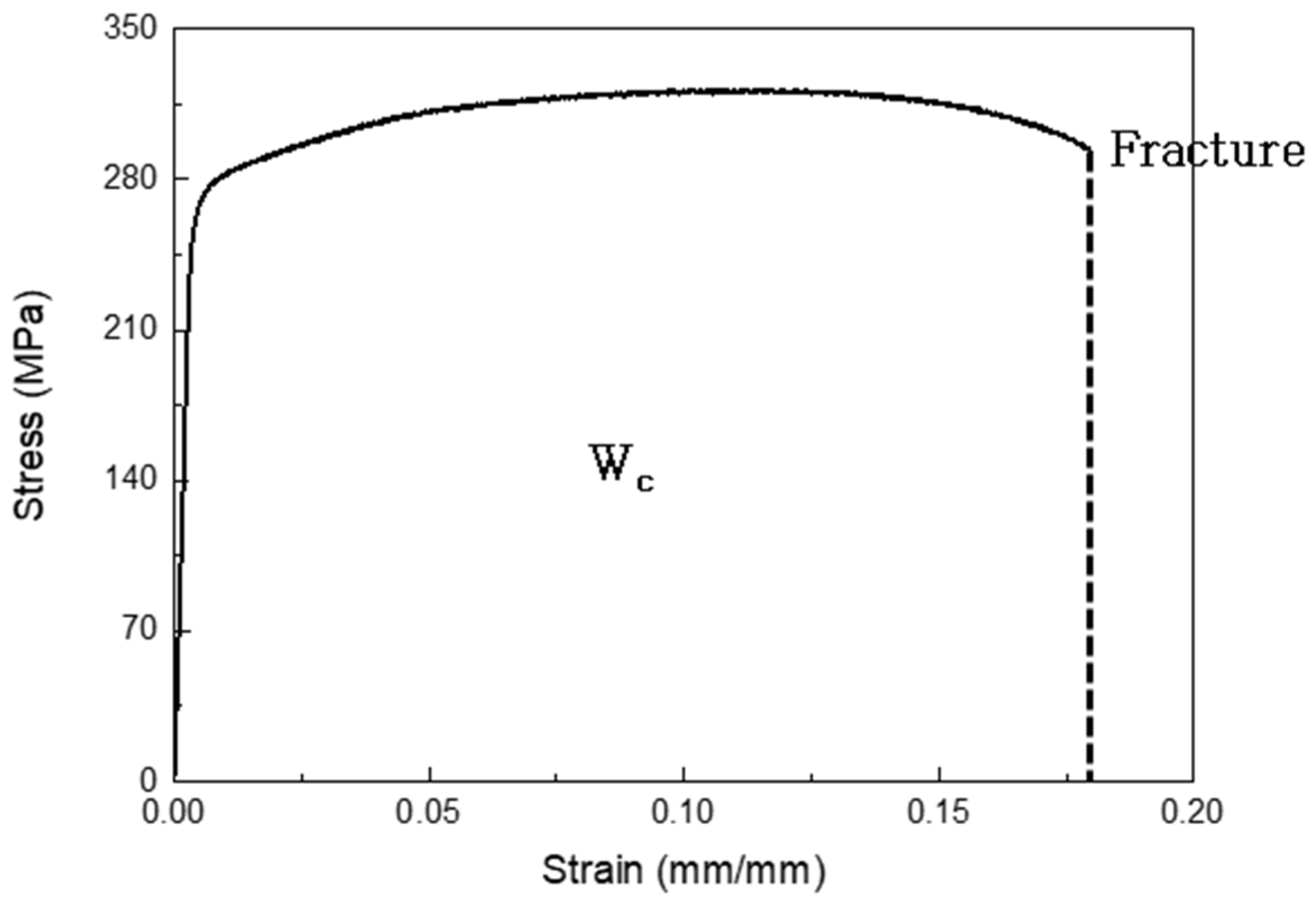


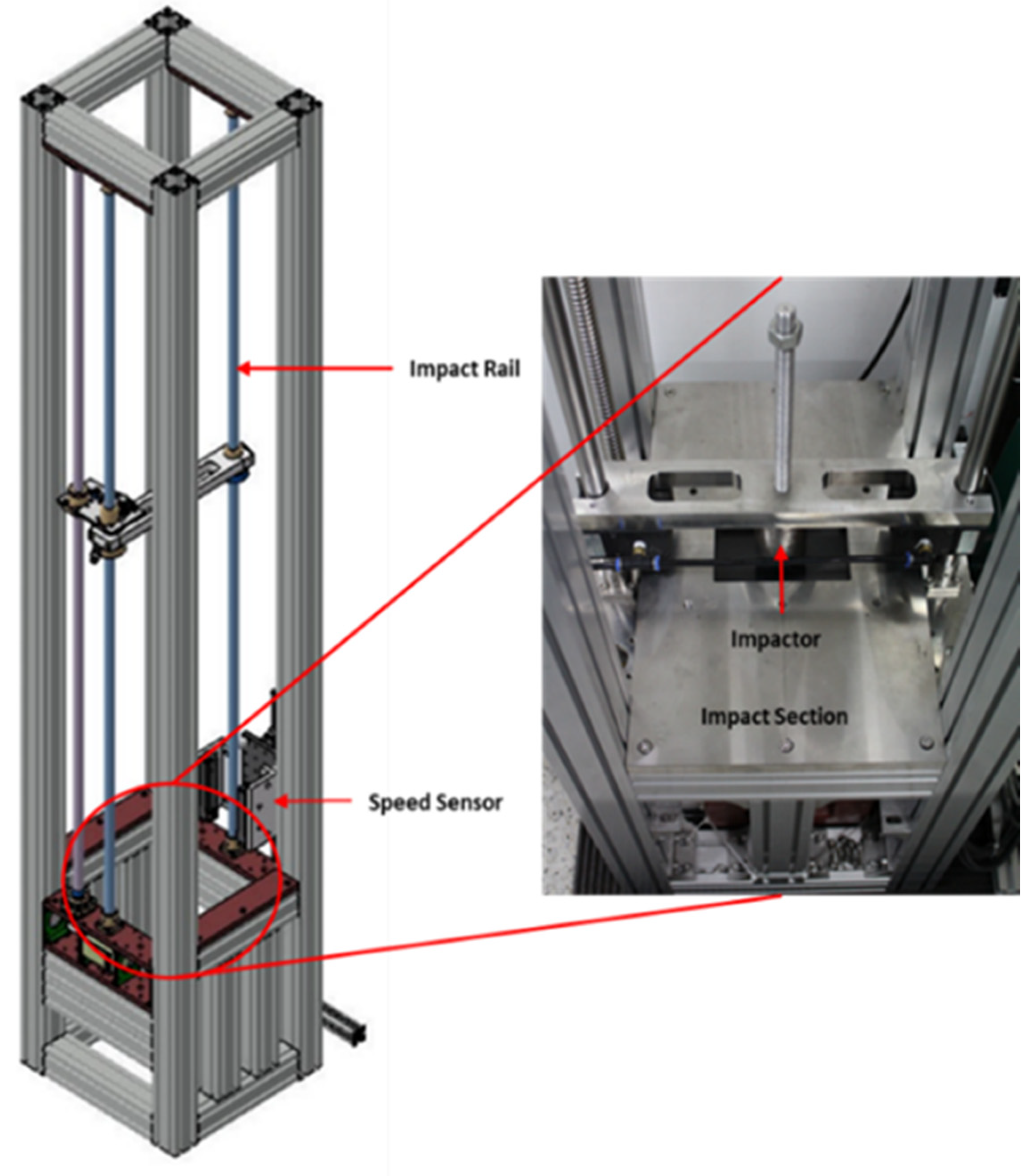

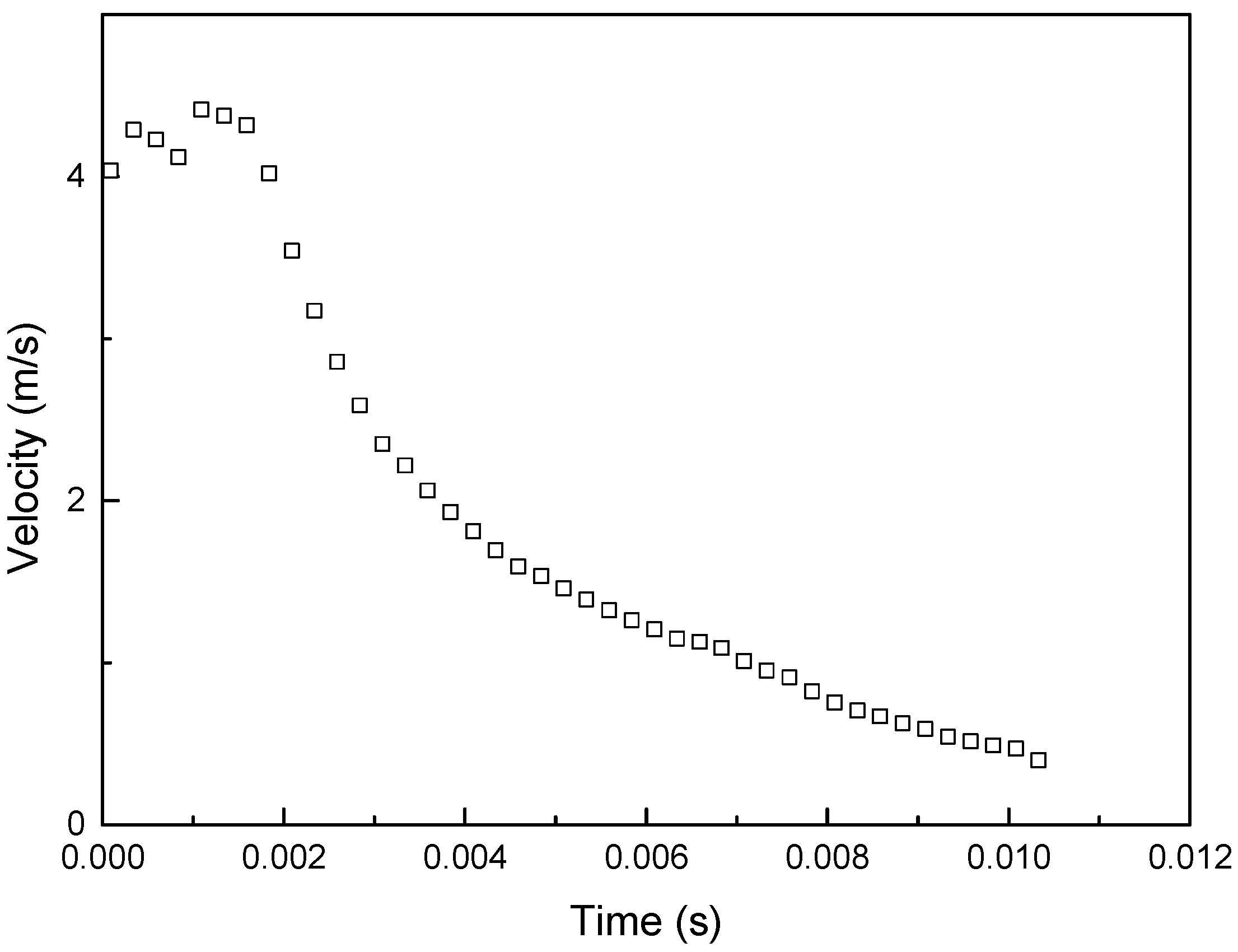
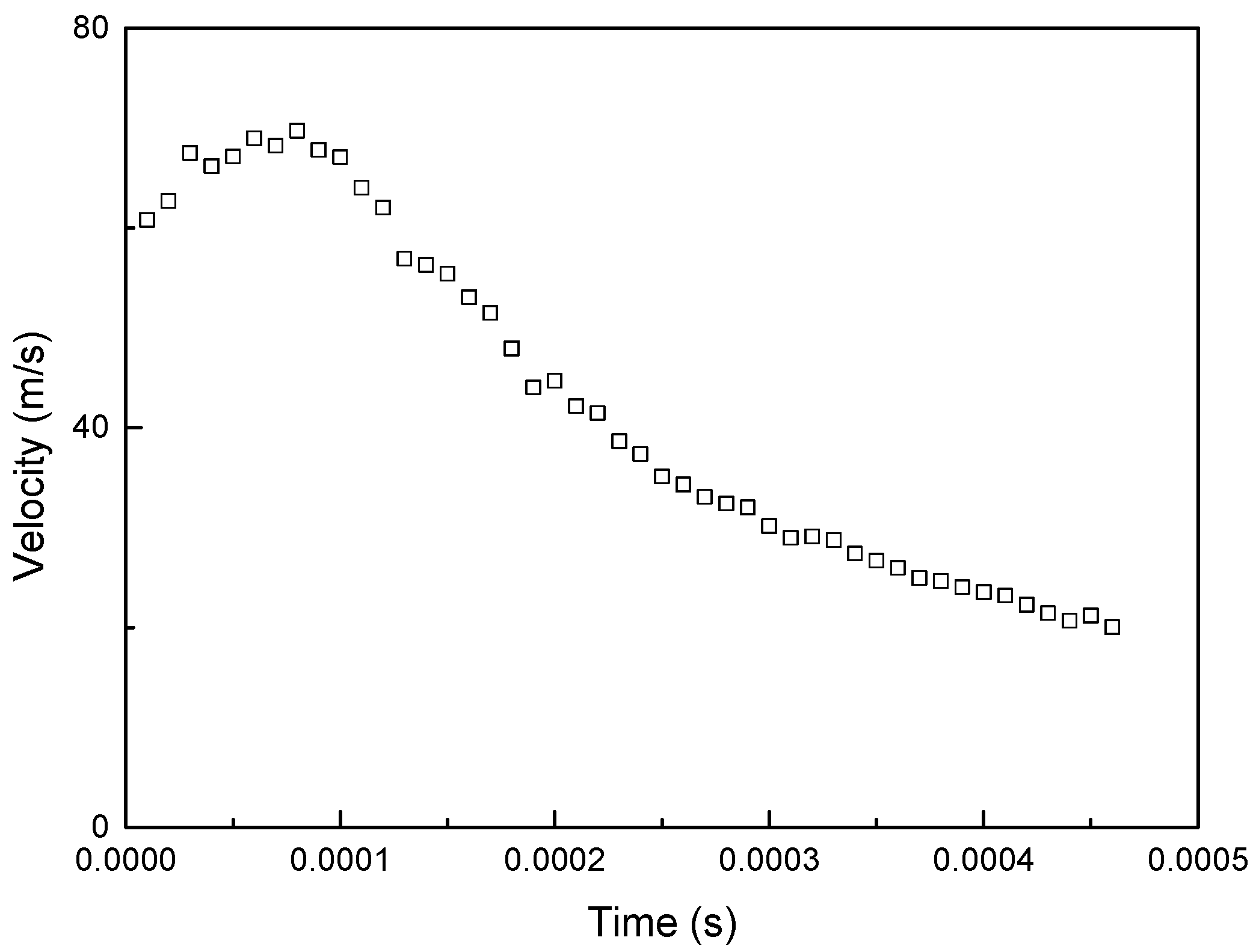
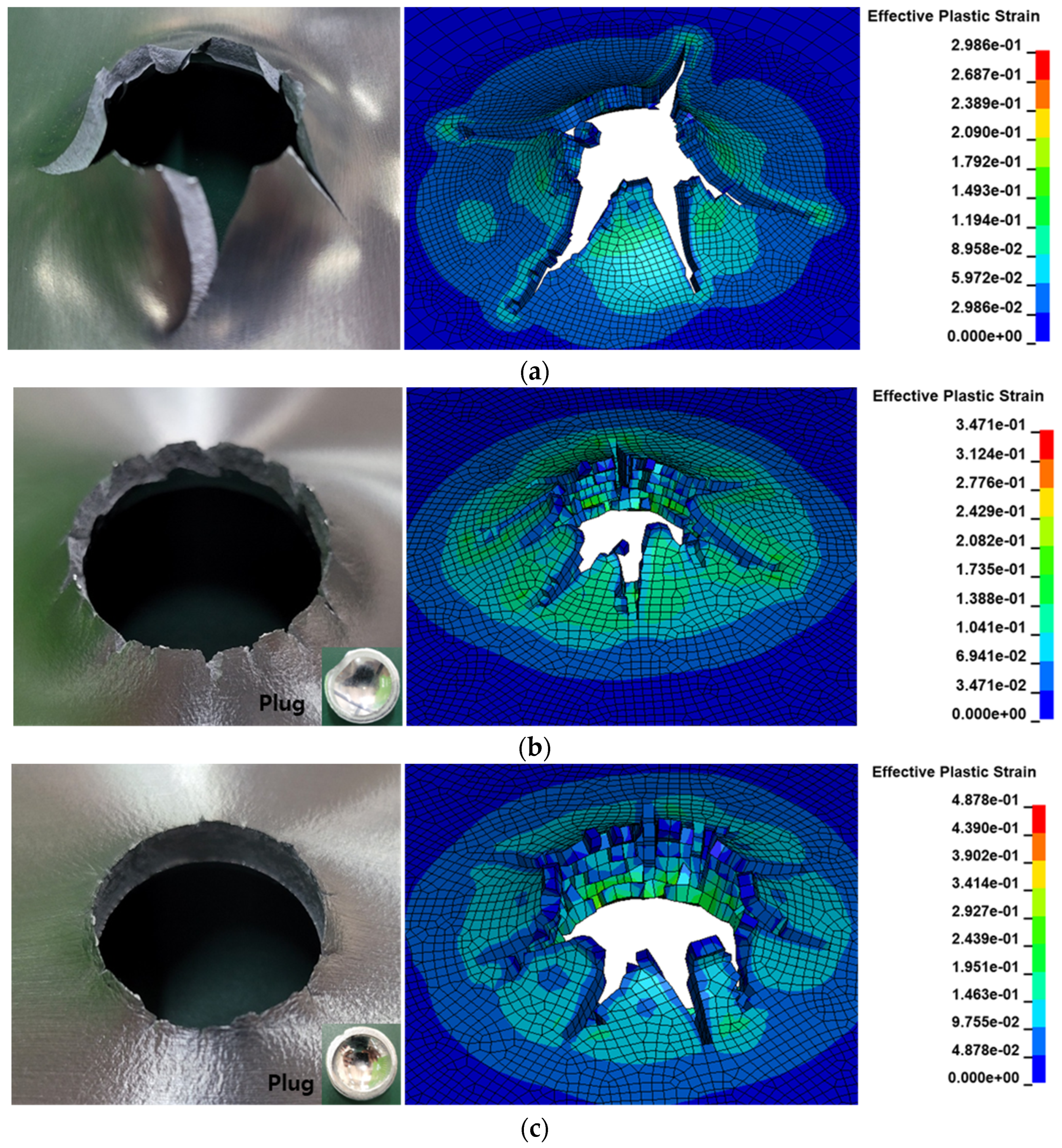
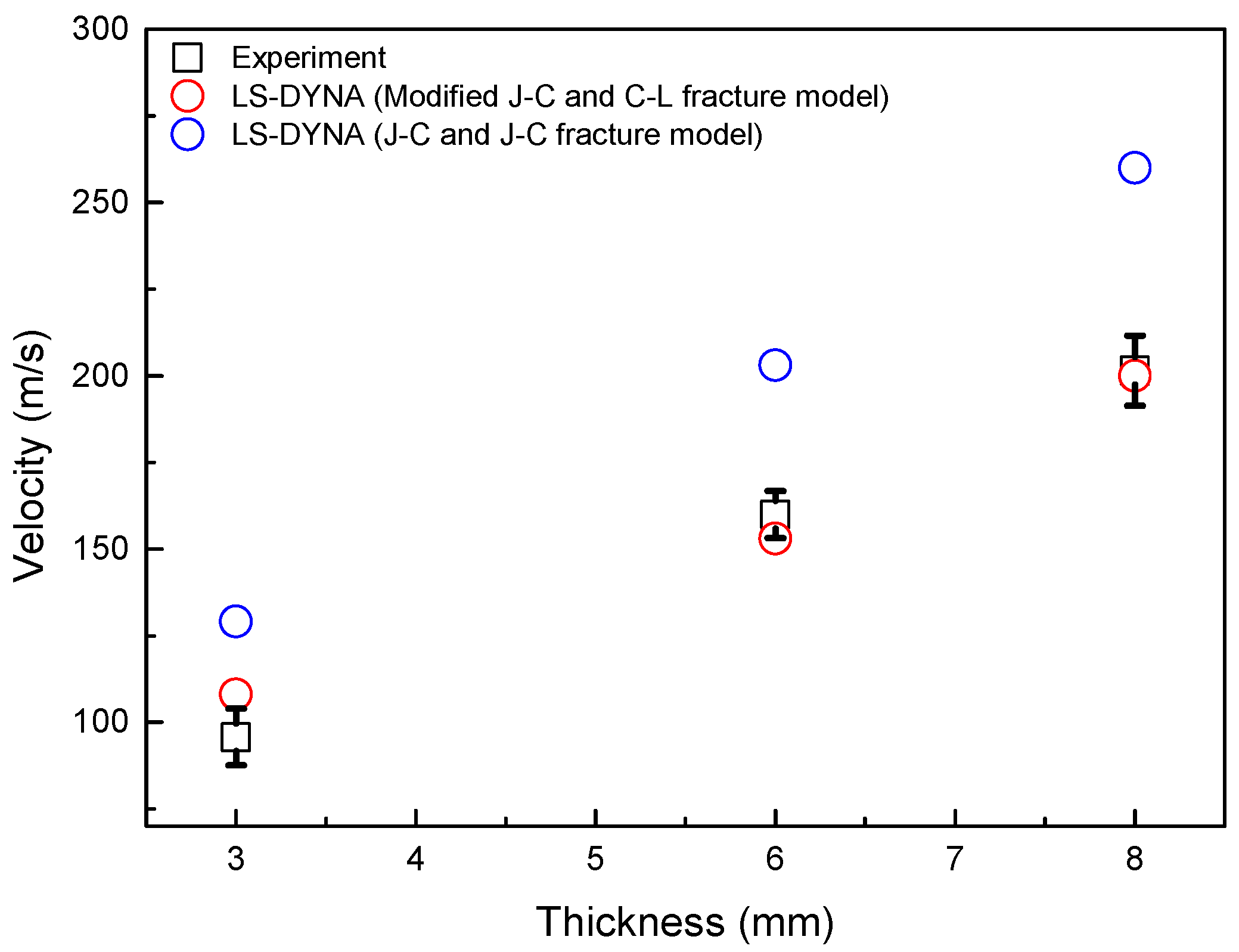
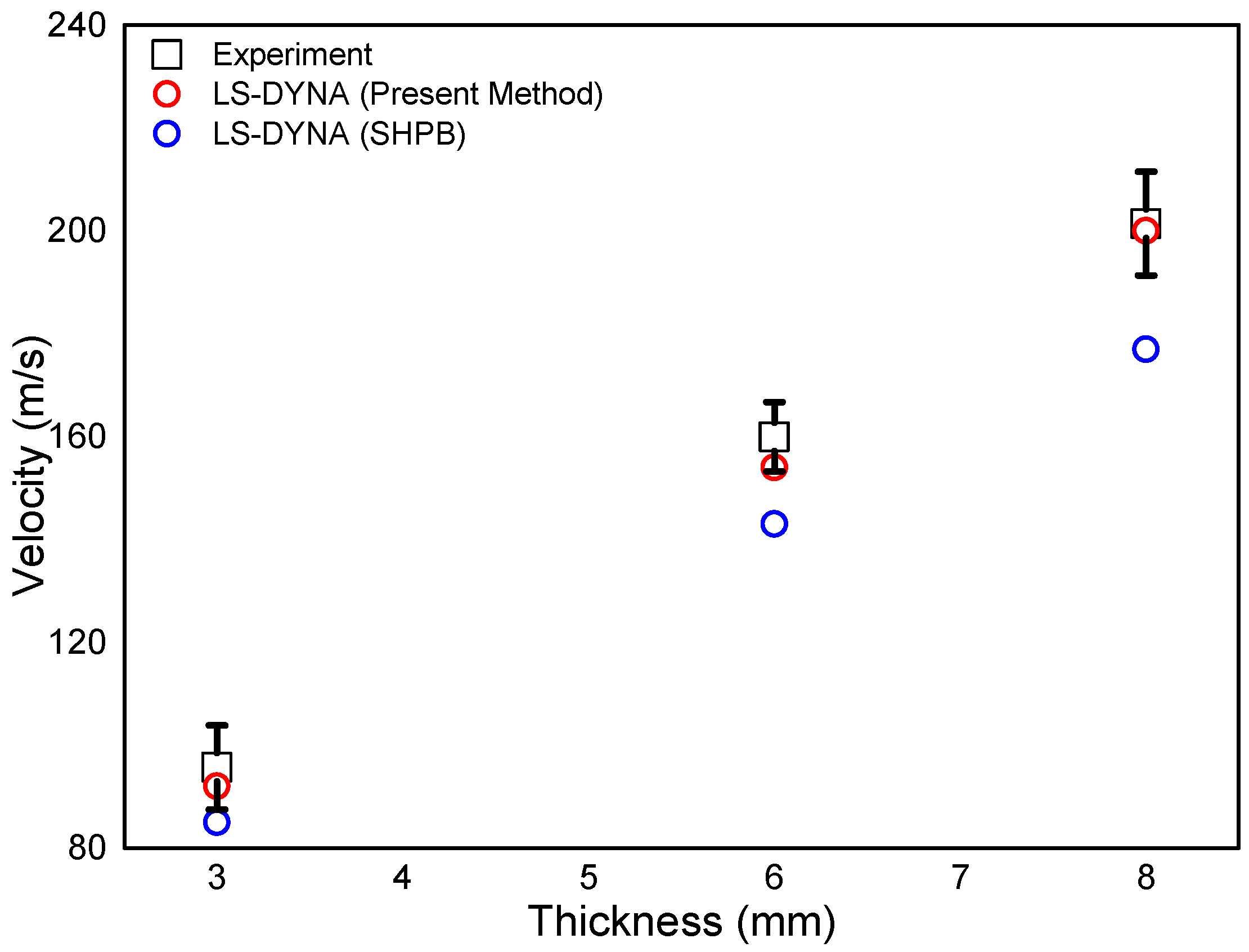

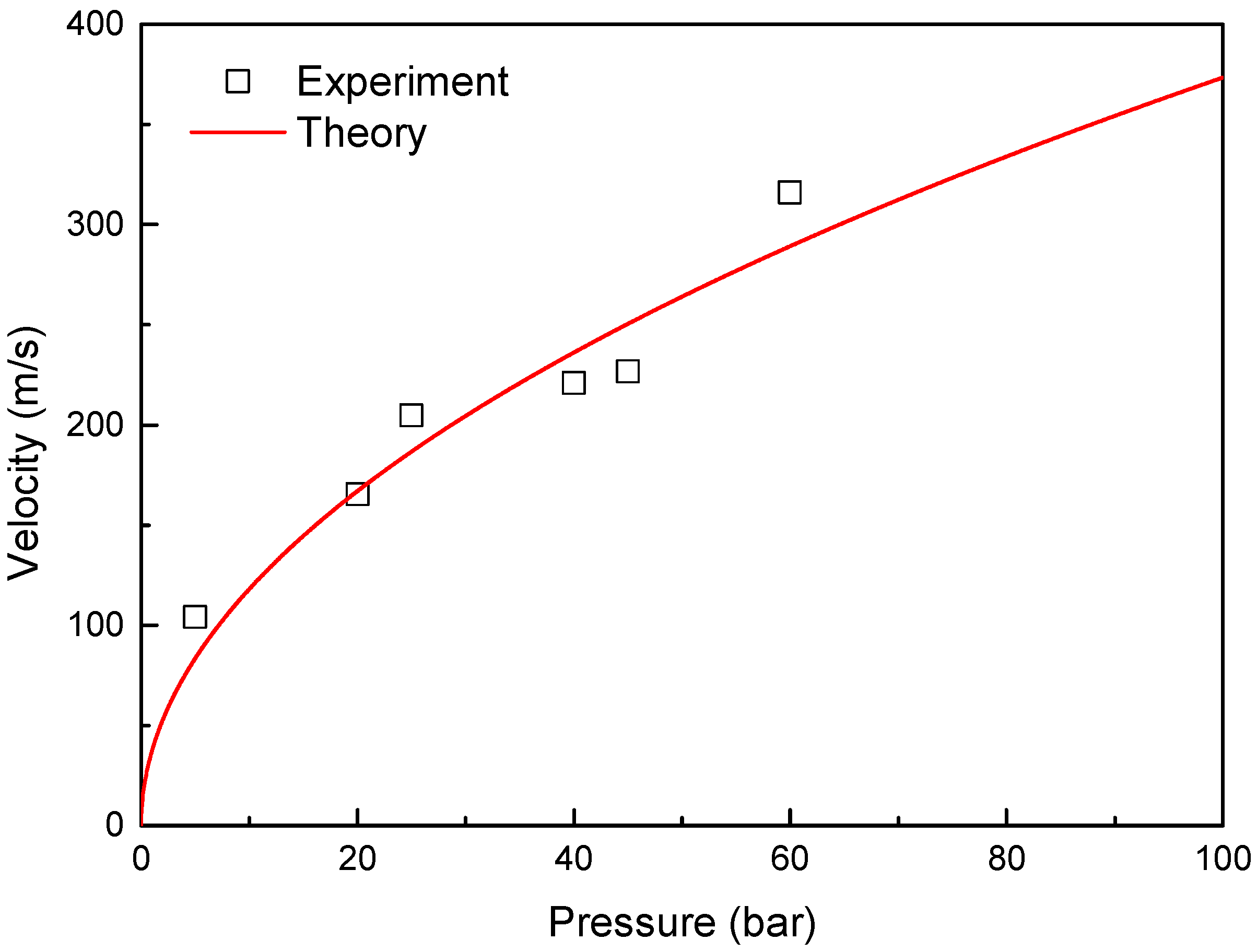






| No. | Velocity (m/s) | Velocity (m/s) |
|---|---|---|
| 1 | 4.166 | 71.42 |
| 2 | 4.985 | 75.39 |
| 3 | 4.743 | 69.62 |
| Average | 4.743 | 72.14 |
| Initial Yield Stress, A (MPa) | 245 | Strain Hardening Parameter, B (MPa) | 233 |
| Strain Hardening Exponent, n | 0.34 | Strain Rate Sensitivity Parameter, C | 0.03 |
| Reference Plastic Strain Rate, s−1 | 0.01 | Strain Energy, Wc (MPa) | 58.5 |
| Material Properties (Aluminum 6061) | |||
|---|---|---|---|
| Density (kg/m3) | 2.713 | Poisson’s Ratio | 0.33 |
| Modulus of Elasticity (GPa) | 68.3 | Specific Heat Capacity (J/(kg·K)) | 890 |
| Shear Modulus (GPa) | 27.7 | ||
| No. | Thickness (mm) | Experiment (m/s) | Analysis (m/s) | Error (%) |
|---|---|---|---|---|
| 1 | 3 | 103.9 (Penetration) | 92 (Critical Velocity) | 3.9 |
| 87.5 (Nonpenetration) | ||||
| 2 | 6 | 166.7 (Penetration) | 154 (Critical Velocity) | 3.7 |
| 153.2 (Nonpenetration) | ||||
| 3 | 8 | 211.5 (Penetration) | 200 (Critical Velocity) | 0.7 |
| 191.3 (Nonpenetration) |
| No. | Velocity (m/s) | Containment Evaluation Result |
|---|---|---|
| 1 | 244.3 | Un-Containment: Complete Penetration |
| 2 | 163.8 | Un-Containment: Non-Complete Penetration |
| 3 | 105.4 | Containment: Rebound, Nonpenetration |
Disclaimer/Publisher’s Note: The statements, opinions and data contained in all publications are solely those of the individual author(s) and contributor(s) and not of MDPI and/or the editor(s). MDPI and/or the editor(s) disclaim responsibility for any injury to people or property resulting from any ideas, methods, instructions or products referred to in the content. |
© 2023 by the authors. Licensee MDPI, Basel, Switzerland. This article is an open access article distributed under the terms and conditions of the Creative Commons Attribution (CC BY) license (https://creativecommons.org/licenses/by/4.0/).
Share and Cite
Byun, S.-W.; Joo, Y.-J.; Lee, S.-Y.; Kim, S.-W. Experimental and Numerical Study on the Perforation Behavior of an Aluminum 6061-T6 Cylindrical Shell. Materials 2023, 16, 7055. https://doi.org/10.3390/ma16217055
Byun S-W, Joo Y-J, Lee S-Y, Kim S-W. Experimental and Numerical Study on the Perforation Behavior of an Aluminum 6061-T6 Cylindrical Shell. Materials. 2023; 16(21):7055. https://doi.org/10.3390/ma16217055
Chicago/Turabian StyleByun, Seon-Woo, Young-Jung Joo, Soo-Yong Lee, and Sang-Woo Kim. 2023. "Experimental and Numerical Study on the Perforation Behavior of an Aluminum 6061-T6 Cylindrical Shell" Materials 16, no. 21: 7055. https://doi.org/10.3390/ma16217055
APA StyleByun, S.-W., Joo, Y.-J., Lee, S.-Y., & Kim, S.-W. (2023). Experimental and Numerical Study on the Perforation Behavior of an Aluminum 6061-T6 Cylindrical Shell. Materials, 16(21), 7055. https://doi.org/10.3390/ma16217055






